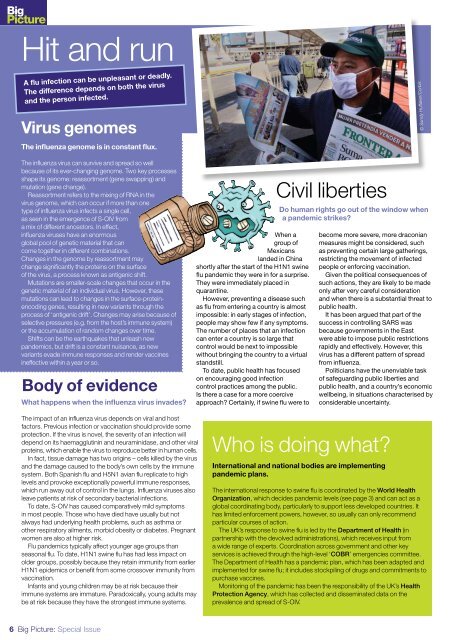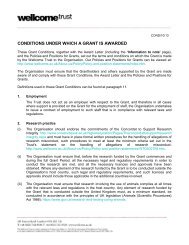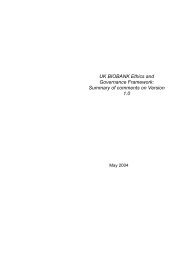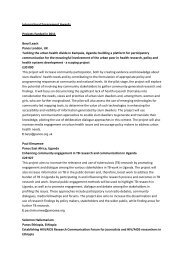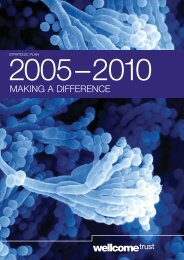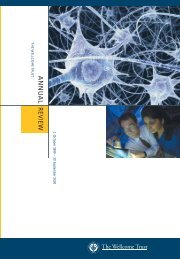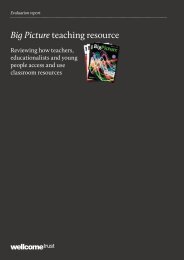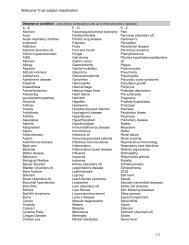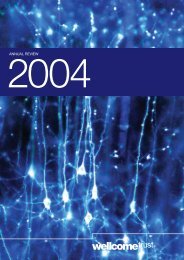Big Picture on Influenza - Wellcome Trust
Big Picture on Influenza - Wellcome Trust
Big Picture on Influenza - Wellcome Trust
- No tags were found...
Create successful ePaper yourself
Turn your PDF publications into a flip-book with our unique Google optimized e-Paper software.
<str<strong>on</strong>g>Big</str<strong>on</strong>g><str<strong>on</strong>g>Picture</str<strong>on</strong>g>Hit and runA flu infecti<strong>on</strong> can be unpleasant or deadly.The difference depends <strong>on</strong> both the virusand the pers<strong>on</strong> infected.© Sandy Huffaker/CorbisVirus genomesThe influenza genome is in c<strong>on</strong>stant flux.The influenza virus can survive and spread so wellbecause of its ever-changing genome. Two key processesshape its genome: reassortment (gene swapping) andmutati<strong>on</strong> (gene change).Reassortment refers to the mixing of RNA in thevirus genome, which can occur if more than <strong>on</strong>etype of influenza virus infects a single cell,as seen in the emergence of S-OIV froma mix of different ancestors. In effect,influenza viruses have an enormousglobal pool of genetic material that cancome together in different combinati<strong>on</strong>s.Changes in the genome by reassortment maychange significantly the proteins <strong>on</strong> the surfaceof the virus, a process known as antigenic shift.Mutati<strong>on</strong>s are smaller-scale changes that occur in thegenetic material of an individual virus. However, thesemutati<strong>on</strong>s can lead to changes in the surface-proteinencodinggenes, resulting in new variants through theprocess of ‘antigenic drift’. Changes may arise because ofselective pressures (e.g. from the host’s immune system)or the accumulati<strong>on</strong> of random changes over time.Shifts can be the earthquakes that unleash newpandemics, but drift is a c<strong>on</strong>stant nuisance, as newvariants evade immune resp<strong>on</strong>ses and render vaccinesineffective within a year or so.Body of evidenceWhat happens when the influenza virus invades?When agroup ofMexicanslanded in Chinashortly after the start of the H1N1 swineflu pandemic they were in for a surprise.They were immediately placed inquarantine.However, preventing a disease suchas flu from entering a country is almostimpossible: in early stages of infecti<strong>on</strong>,people may show few if any symptoms.The number of places that an infecti<strong>on</strong>can enter a country is so large thatc<strong>on</strong>trol would be next to impossiblewithout bringing the country to a virtualstandstill.To date, public health has focused<strong>on</strong> encouraging good infecti<strong>on</strong>c<strong>on</strong>trol practices am<strong>on</strong>g the public.Is there a case for a more coerciveapproach? Certainly, if swine flu were toCivil libertiesDo human rights go out of the window whena pandemic strikes?become more severe, more drac<strong>on</strong>ianmeasures might be c<strong>on</strong>sidered, suchas preventing certain large gatherings,restricting the movement of infectedpeople or enforcing vaccinati<strong>on</strong>.Given the political c<strong>on</strong>sequences ofsuch acti<strong>on</strong>s, they are likely to be made<strong>on</strong>ly after very careful c<strong>on</strong>siderati<strong>on</strong>and when there is a substantial threat topublic health.It has been argued that part of thesuccess in c<strong>on</strong>trolling SARS wasbecause governments in the Eastwere able to impose public restricti<strong>on</strong>srapidly and effectively. However, thisvirus has a different pattern of spreadfrom influenza.Politicians have the unenviable taskof safeguarding public liberties andpublic health, and a country’s ec<strong>on</strong>omicwellbeing, in situati<strong>on</strong>s characterised byc<strong>on</strong>siderable uncertainty.The impact of an influenza virus depends <strong>on</strong> viral and hostfactors. Previous infecti<strong>on</strong> or vaccinati<strong>on</strong> should provide someprotecti<strong>on</strong>. If the virus is novel, the severity of an infecti<strong>on</strong> willdepend <strong>on</strong> its haemagglutinin and neuraminidase, and other viralproteins, which enable the virus to reproduce better in human cells.In fact, tissue damage has two origins – cells killed by the virusand the damage caused to the body’s own cells by the immunesystem. Both Spanish flu and H5N1 avian flu replicate to highlevels and provoke excepti<strong>on</strong>ally powerful immune resp<strong>on</strong>ses,which run away out of c<strong>on</strong>trol in the lungs. <strong>Influenza</strong> viruses alsoleave patients at risk of sec<strong>on</strong>dary bacterial infecti<strong>on</strong>s.To date, S-OIV has caused comparatively mild symptomsin most people. Those who have died have usually but notalways had underlying health problems, such as asthma orother respiratory ailments, morbid obesity or diabetes. Pregnantwomen are also at higher risk.Flu pandemics typically affect younger age groups thanseas<strong>on</strong>al flu. To date, H1N1 swine flu has had less impact <strong>on</strong>older groups, possibly because they retain immunity from earlierH1N1 epidemics or benefit from some crossover immunity fromvaccinati<strong>on</strong>.Infants and young children may be at risk because theirimmune systems are immature. Paradoxically, young adults maybe at risk because they have the str<strong>on</strong>gest immune systems.Who is doing what?Internati<strong>on</strong>al and nati<strong>on</strong>al bodies are implementingpandemic plans.The internati<strong>on</strong>al resp<strong>on</strong>se to swine flu is coordinated by the World HealthOrganizati<strong>on</strong>, which decides pandemic levels (see page 3) and can act as aglobal coordinating body, particularly to support less developed countries. Ithas limited enforcement powers, however, so usually can <strong>on</strong>ly recommendparticular courses of acti<strong>on</strong>.The UK’s resp<strong>on</strong>se to swine flu is led by the Department of Health (inpartnership with the devolved administrati<strong>on</strong>s), which receives input froma wide range of experts. Coordinati<strong>on</strong> across government and other keyservices is achieved through the high-level ‘COBR’ emergencies committee.The Department of Health has a pandemic plan, which has been adapted andimplemented for swine flu; it includes stockpiling of drugs and commitments topurchase vaccines.M<strong>on</strong>itoring of the pandemic has been the resp<strong>on</strong>sibility of the UK’s HealthProtecti<strong>on</strong> Agency, which has collected and disseminated data <strong>on</strong> theprevalence and spread of S-OIV.6 <str<strong>on</strong>g>Big</str<strong>on</strong>g> <str<strong>on</strong>g>Picture</str<strong>on</strong>g>: Special Issue


